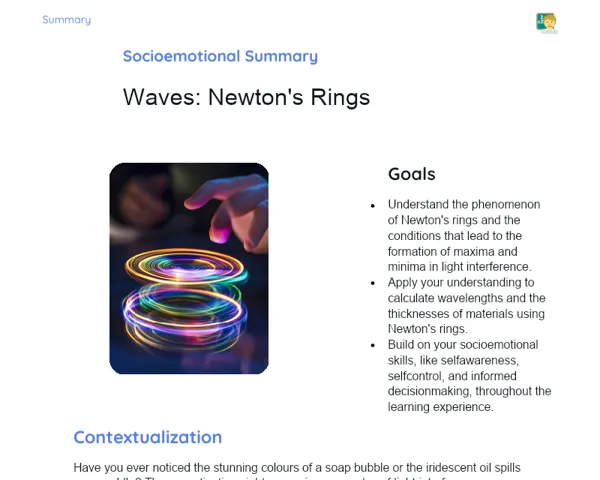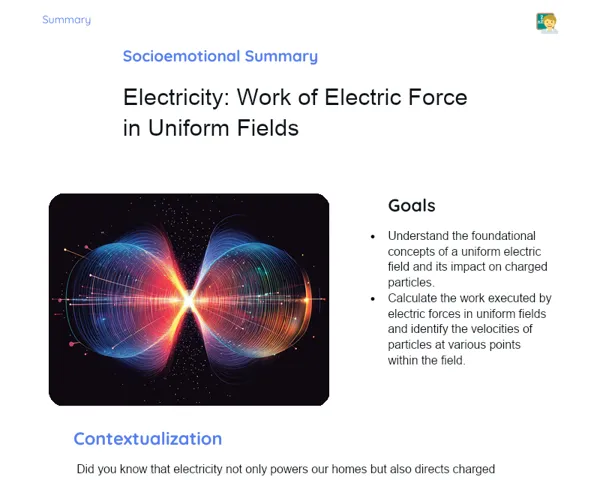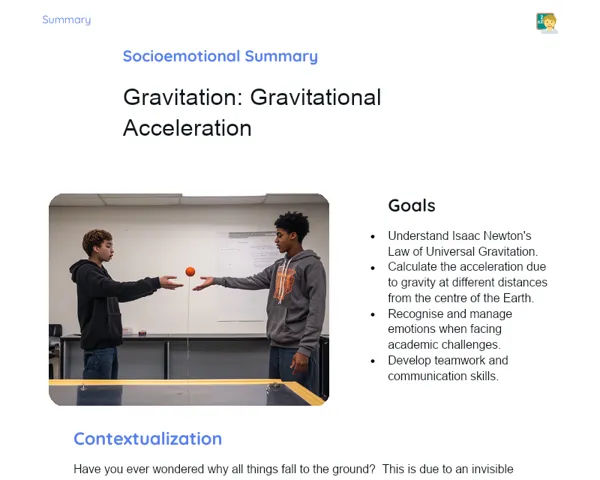Socioemotional Summary Conclusion
Goals
1. Grasp the connection between wave speed and the material of the string.
2. Enhance skills to calculate wave speed across various string types.
3. Apply the concept of wave speed to familiar, everyday examples.
4. Consider how different materials and tensions affect wave propagation.
Contextualization
Did you know that the music we enjoy is closely linked to the physics of waves? 🎸✨ When strumming a guitar, for instance, the speed of the wave in the strings shapes the sounds we hear. The choice of string material, be it nylon or steel, plays a huge role in this, leading to distinct sound differences. Understanding this not only deepens our grasp of physics but also enriches our appreciation of the science behind our daily hobbies and passions!
Exercising Your Knowledge
Definition of Wave
A wave is a disturbance that travels through a medium, transferring energy without transporting matter. When you see a wave moving along a string, the string itself doesn’t shift side to side; only the energy of the disturbance moves.
-
Disturbance: A wave is essentially a disturbance or temporary change that travels through a medium.
-
Propagation: The wave carries energy along the string, while the string's matter stays in place.
-
Energy vs Matter: It's crucial to understand that waves move energy rather than matter, distinguishing wave behaviour from simple physical movements.
Components of the Wave
Waves have key components: crest, trough, amplitude, wavelength, and frequency. These elements help describe and classify waves, aiding our understanding of their behaviour and characteristics.
-
Crest: The peak of the wave, where the disturbance is at its highest.
-
Trough: The lowest point of the wave, where the disturbance reaches its minimum.
-
Amplitude: The distance between the equilibrium line and the crest (or trough). Amplitude relates to the energy of the wave.
-
Wavelength: The distance between two consecutive crests (or troughs), determining the wave's periodicity.
-
Frequency: The number of waves that pass a given point in a set time frame. A high frequency means more waves in less time.
Wave Speed Equation
The core formula for finding wave speed on a string is v = √(T/μ), where v represents speed, T is the tension in the string, and μ is the linear mass density of the string. This equation highlights how different physical factors influence wave speed.
-
Tension (T): The force applied along the string. Increased tension leads to a higher wave propagation speed.
-
Linear Mass Density (μ): The mass per unit length of the string. Denser strings result in slower wave speeds.
-
Interrelationships: Knowing how tension and linear mass density interact allows us to predict and manipulate wave speeds in real-world applications.
Key Terms
-
Wave: A disturbance that carries energy without moving matter.
-
Crest: The peak of the wave.
-
Trough: The lowest point of the wave.
-
Amplitude: The distance between the equilibrium line and the peak/trough.
-
Wavelength: The distance between two consecutive peaks or troughs.
-
Frequency: The number of waves passing through a point in a designated time.
-
Tension (T): Force exerted along the string.
-
Linear Mass Density (μ): Mass per unit length of the string.
For Reflection
-
How do the different parts of a wave connect to real-life situations, like playing musical instruments or watching waves at the beach?
-
In what ways might a grasp of wave properties help you make better choices in various contexts, such as selecting materials for school projects or solving everyday issues?
-
How did you handle your emotions during the lab session? What techniques did you use to remain calm and work well with your group?
Important Conclusions
-
We learned how wave speed is influenced by the string's material.
-
We figured out how to calculate wave speed in various string types using the equation v = √(T/μ).
-
We reflected on the practical uses of this knowledge in everyday scenarios, such as music and other physical phenomena.
-
We developed key socio-emotional skills, such as teamwork and emotional regulation during challenging tasks.
Impacts on Society
Understanding waves and their properties profoundly affects our everyday life. For example, when playing music, our knowledge about waves helps us create harmonious sounds and pleasing melodies. The choice of string material and tension impacts sound quality, and this knowledge allows musicians to refine their performance and instrument selection. 🎆🎶 Beyond music, wave physics plays vital roles in fields like telecommunications and medical technology. In telecommunications, waves transmit signals for radio, TV, and internet, linking people globally. Meanwhile, in medical tech, understanding ultrasonic waves enables non-invasive exams such as ultrasounds, leading to more accurate diagnoses. 🚀🩺
Dealing with Emotions
I suggest you do a self-reflection exercise at home using the RULER method. First, identify your feelings while engaging with this topic: were you frustrated, curious, or excited? Understand what caused those feelings; was it the complexity of the content or group dynamics? Accurately name your emotions and express them suitably. For instance, if you felt frustrated, try sharing it constructively with your classmates or family. Lastly, manage your emotions by seeking strategies such as taking breaks to relax, practicing breathing techniques, or having discussions to clarify doubts. This exercise will help you effectively handle your emotions and boost your emotional intelligence. 🙂✊
Study Tips
-
Review the fundamental concepts of waves and their features using educational videos and online animations for better visual understanding.
-
Practice solving problems related to wave speed on various string types to strengthen your grasp of the formula v = √(T/μ).
-
Conduct small experiments at home with different string types and tension measurements, comparing practical results with theoretical expectations for a hands-on learning experience.



